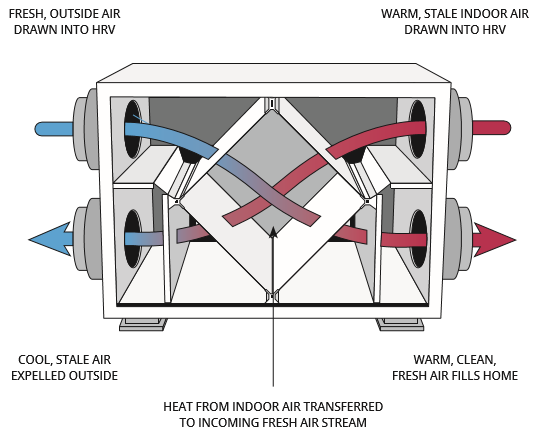The Definitive Guide to HRV Integration in Residential Spaces
Discovering the Conveniences of Heat Recovery Ventilation for Energy Efficiency in Homes
Heat Recovery Ventilation (HRV) systems supply homeowners a functional approach to improving power effectiveness. By reclaiming warmth from outgoing air, these systems can substantially lower home heating and air conditioning expenses. Additionally, they offer a consistent supply of fresh air, boosting indoor air high quality and comfort degrees. As homeowners take into consideration lasting choices, recognizing the subtleties of HRV systems comes to be significantly vital. What elements should one examine before making such a financial investment?
Recognizing Heat Recovery Ventilation Systems

How HRV Improves Indoor Air High Quality

Energy Financial Savings: The Monetary Benefits of HRV
Making best use of power effectiveness, heat recovery ventilation (HRV) systems provide considerable economic benefits for home owners. By recovering and recycling warmth from exhaust air, HRVs significantly lower home heating and cooling expenses. This technology can cause power cost savings of up to 30%, depending upon environment check and usage patterns. Homeowners commonly see decreased energy costs shortly after installation, making HRVs an economically wise financial investment in time. In addition, many regions offer motivations or refunds for energy-efficient upgrades, further improving the economic charm. As energy rates remain to climb, the cost-effectiveness of HRVs comes to be progressively clear. Generally, the incorporation of HRV systems not just promotes power efficiency yet also adds to lasting economic savings for homes.
The Environmental Impact of Heat Recovery Ventilation
A considerable environmental benefit of heat recovery ventilation (HRV) systems exists in their capacity to lower total energy consumption. By recovering heat from exhaust visit this web-site air and transferring it to incoming fresh air, HRV systems decrease the demand for energy-intensive home heating and cooling techniques. This decrease in power need adds to lower greenhouse gas discharges, as less fossil gas is called for to maintain comfortable indoor temperatures. Furthermore, HRV systems improve indoor air high quality by successfully trading stale air with fresh exterior air, decreasing reliance on mechanical air conditioning systems that can hurt the setting. In general, the execution of HRV systems sustains sustainable living methods and lines up find more with global efforts to combat climate adjustment by promoting power efficiency in household setups.
Choosing the Right HRV System for Your Home
How can homeowners assure they select the ideal heat recovery ventilation (HRV) system for their requirements? Initially, they need to evaluate their home's dimension and format, as these variables influence airflow requirements. Next, evaluating the system's efficiency rankings is important, as greater ratings suggest much better performance and energy financial savings. Home owners ought to also think about installment and upkeep expenses, comparing different brands and designs for worth. Additionally, it is essential to assess sound degrees, as some systems run even more quietly than others. Consulting with HVAC specialists can supply customized recommendations based on particular home conditions. Analyzing customer reviews and service warranties can aid in making an educated decision, guaranteeing that the selected HRV system successfully boosts indoor air top quality and energy performance.
Often Asked Inquiries

Exactly how Usually Should I Tidy or Keep My HRV System?
The regularity of cleansing or keeping a warmth healing ventilation (HRV) system commonly depends on use and environmental aspects. Typically, it is a good idea to execute maintenance every six months to ensure peak performance and air high quality.

Can HRV Systems Help Reduce Humidity Degrees Inside Your Home?
HRV systems can effectively minimize interior humidity levels by trading stagnant, humid air with fresh, drier air from outside. HRV Heat Recovery Ventilation. This procedure helps maintain a well balanced indoor atmosphere, enhancing convenience and protecting against moisture-related problems
What Is the Lifespan of a Typical HRV System?
The lifespan of a regular heat recovery ventilation (HRV) system differs, typically lasting between 10 to 15 years. Routine upkeep can extend its efficiency and operational life, ensuring peak efficiency throughout its usage duration.
Exist Any Sound Interest In HRV Equipments?
Noise issues with HRV systems can emerge, specifically from fan procedure. Nevertheless, several modern units are developed to decrease audio levels, ensuring they operate silently while maintaining efficiency, which attends to potential disturbances in living environments.
Can I Set Up an HRV System Myself, or Do I Required a Specialist?
The private contemplated whether to install the heat recovery ventilation (HRV) system personally or work with an expert. Generally, while DIY installment is feasible, know-how assurances proper performance and compliance with local building regulations, boosting system performance.